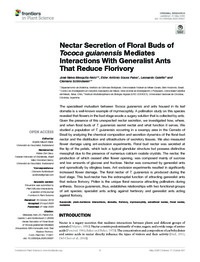Nectar secretion of floral buds of tococa guianensis mediates interactions with generalist ants that reduce florivory
Autor
Mesquita-Neto, José N.
Sousa-Paiva, Elder A.
Galetto, Leonardo
Schlindwein, Clemens
Fecha
2020Resumen
The specialised mutualism between Tococa guianensis and ants housed in its leaf domatia is a well-known example of myrmecophily. A pollination study on this species revealed that flowers in the bud stage exude a sugary solution that is collected by ants. Given the presence of this unexpected nectar secretion, we investigated how, where, and when floral buds of T. guianensis secret nectar and what function it serves. We studied a population of T. guianensis occurring in a swampy area in the Cerrado of Brazil by analyzing the chemical composition and secretion dynamics of the floral-bud nectar and the distribution and ultrastructure of secretory tissues. We also measured flower damage using ant-exclusion experiments. Floral bud nectar was secreted at the tip of the petals, which lack a typical glandular structure but possess distinctive mesophyll due to the presence of numerous calcium oxalate crystals. The nectar, the production of which ceased after flower opening, was composed mainly of sucrose and low amounts of glucose and fructose. Nectar was consumed by generalist ants and sporadically by stingless bees. Ant exclusion experiments resulted in significantly increased flower damage. The floral nectar of T. guianensis is produced during the bud stage. This bud-nectar has the extranuptial function of attracting generalist ants that reduce florivory. Pollen is the unique floral resource attracting pollinators during anthesis. Tococa guianensis, thus, establishes relationships with two functional groups of ant species: specialist ants acting against herbivory and generalist ants acting against florivory.
Fuente
Frontiers in plant science, 11, 627Identificador DOI
doi.org/10.3389/fpls.2020.00627Colecciones
La publicación tiene asociados los siguientes ficheros de licencia:


